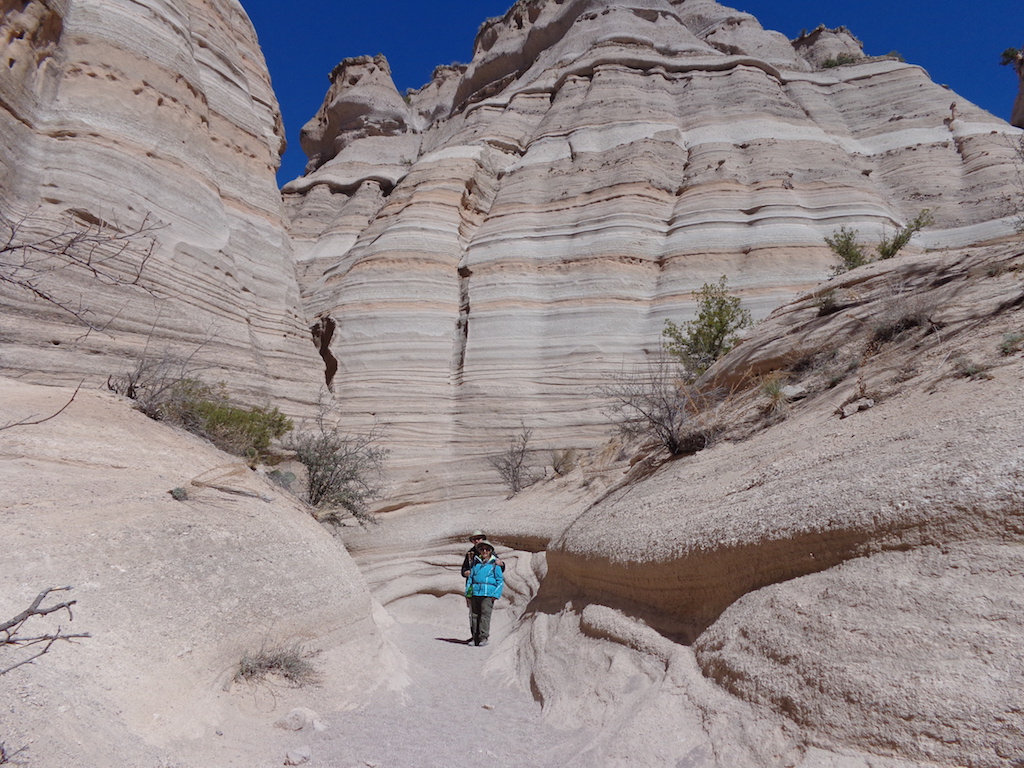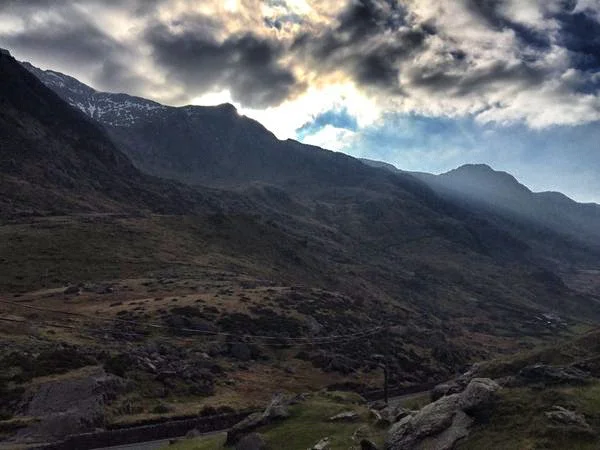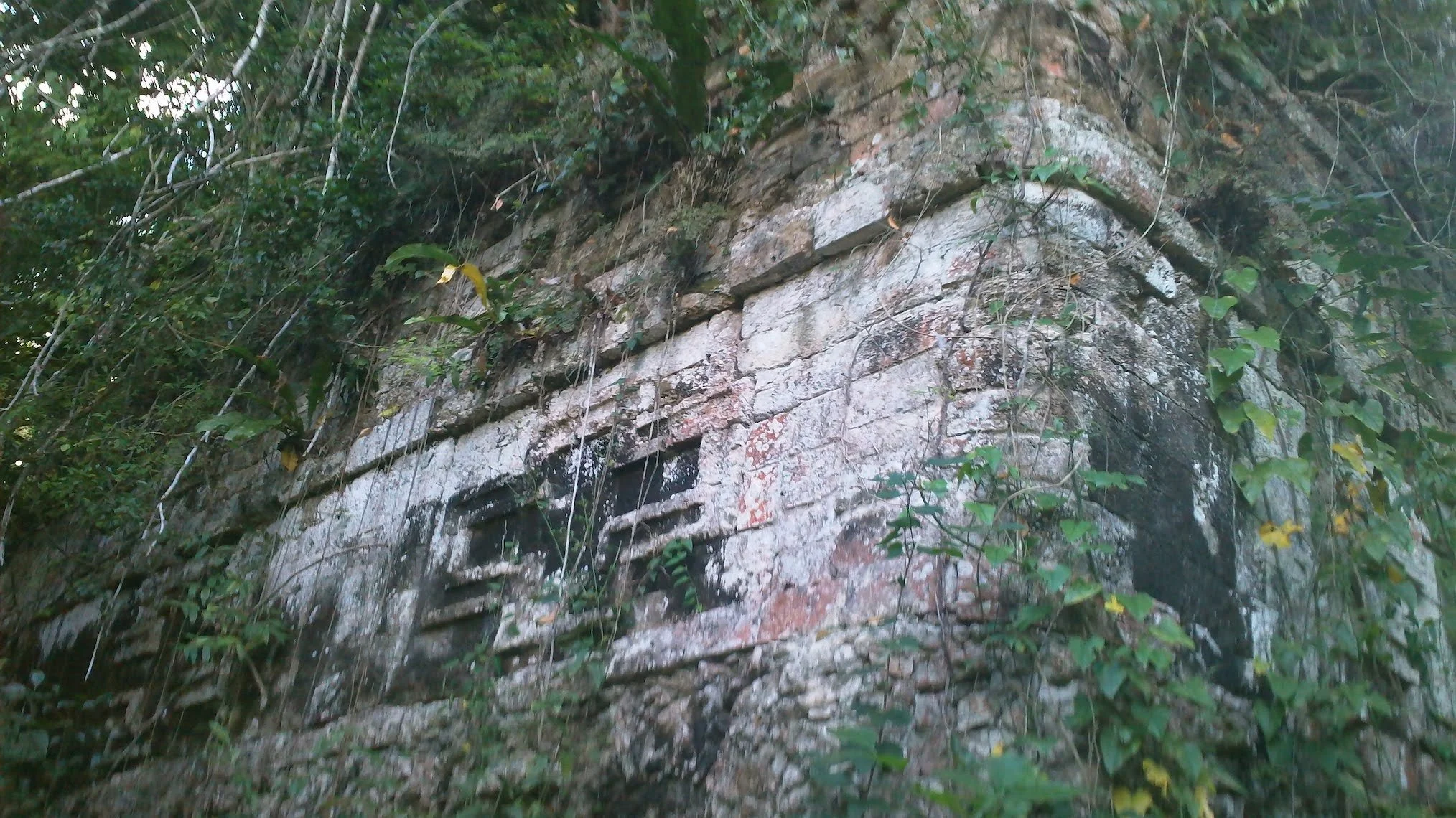On The Trail of Discovery in New Mexico: Hiking Tent Rocks
by Carolyn Handler Miller
We’d been hiking up the Tent Rocks trail for about a quarter of a mile, and it had been easy going. The path was wide and sandy, with no obstacles and only a slight incline. I was amused when we came to an advisory sign about conditions that lay ahead. It warned that we should expect to scramble over large rocks, squeeze through narrow slots in the canyon, and climb a steep rise in the trail.
“Sounds like fun!” I cheerily told my husband.
It was our first hike at Tent Rocks and a welcome reward after an intense cycle of work. We had planned to go to Paris and London during Spring Break, one of the few times in the academic calendar when my husband could get away from his duties as a professor and I didn’t have any deadlines. Unfortunately, the timing for such a trip wasn’t right, for the big show I’d been working on for a year was opening right in the middle of Spring Break. So we cancelled our overseas plans. I was disappointed but determined to go on some kind of outing, and a hike at Tent Rocks sounded like the perfect mini-escape.
Tent Rocks is one of the geographic wonders of Northern New Mexico, featuring bizarre formations shaped like tents and pudgy, tubular arrows, otherwise known as hoodoos. The area is officially known as Kasha Katuwe National Monument and is sacred to the Cochiti Pueblo People who live nearby. It is less than an hour’s drive from our house in Santa Fe and offered an opportunity for a picnic lunch, one of my favorite forms of outdoor recreation.
After passing the advisory sign, we continued enjoying the scenery, admiring the striped red and gold cliffs, the stone formations and handsome Ponderosa Pines, some with their twisted roots exposed so they seemed to be standing on tiptoes. Gradually the trail narrowed, and some of the passages in the canyon were so slender we almost had to turn sideways to slip our way through. It was a lark maneuvering through them.
Slot Canyon, Kasha-Katuwe Tent Rocks National Monument, New Mexico.
But then we could see that the hikers ahead of us had stopped, and were facing a long line of hikers coming towards them. What was going on? After studying the situation, we could see that there was some sort of barrier across the trail—large boulders. Only a skinny passageway led between them, about the width of a person’s foot. It was far too narrow to squeeze your body through. Both groups of hikers were evaluating the rocks, trying to figure out the safest way over them. Cautiously, a few of the up-going group would haul themselves over the boulders, and then a few from the descending group would lower themselves down.
Eventually, it was our turn. My husband stood behind me, planning to push from the rear if needed. I got part way over and then got stuck. But a couple of well-muscled men from the descending group, who appeared to be members of a mountaineering club, helpfully extended their hands. I grabbed them and they pulled me over. I was a little embarrassed that I needed assistance, but was grateful they’d offered their help.
We went on, carefree, through the narrow canyon, until we came to another blockade of boulders. This time, I was determined to surmount it on my own, but once again I needed help, and another helpful man was there to pull me over. I thanked him, but in my heart I felt ashamed. Why couldn’t I get over these rocks by myself, I wondered. It was a little humiliating. I remembered that I’d read on the Tent Rocks website that the trail was so easy that any able-bodied person could do it, anybody not in a wheelchair, and that two four-year old boys had recently gotten to the top without any trouble. I’m allegedly able-bodied and have much longer legs than any four year old, but I was struggling. Something was amiss here.
Still, we trudged on. My husband had gotten over the boulders without help, but he was beginning to tire, and the trail was getting steeper. He had a vulnerable knee and it was starting to complain. He decided it was time to sit it out, and was fine to let me go on while he relaxed on a rock and enjoyed the scenery.
The path ahead was strewn with rocks and steeper than the first part, but I was determined to reach the top to behold the glorious view that was supposedly waiting. I was making decent headway when the tip of my boot caught on a rock and I plopped over backwards into a bowl-shaped depression. I looked like an upside turtle and could not extract myself. Luckily, two more helpful men pulled me out. My hip was bruised but otherwise, I seemed to be OK.
I gritted my teeth and pushed on, even though my knees started to feel wobbly and my legs felt a little like jelly. Still, I was committed to getting to the top. But then, the trail twisted around an outcrop and I saw what had to be done to actually reach the summit: scaling a tall rocky staircase that from my vantage point looked almost vertical. I studied at it for a while, but the more I focused on it, the steeper it seemed. It looked like a religious painting of a rugged stairway to heaven. No, I realized sadly, I cannot do it. My legs simply are not up to it, even if it is heaven. And if I slipped, I could slide right over the edge into oblivion – into hell, I supposed.
Reluctantly, I turned around and hobbled down the trail to where my husband was waiting. He looked at me in alarm, surprised to see me so soon and looking so wobbly. “Are you OK?” he wanted to know. “What happened? Did you fall and hurt yourself?”
“I did take a little tumble,” I admitted. “But that’s not the trouble. It… it isn’t physical. I paused, finding it hard to confess the nature of my injury. Finally I came out with it. “It’s how I feel. Inside. My… my pride is hurt,” I declared. “I am ashamed I cannot finish this trail.”
My husband did not view it as a humiliation, though. He thought my turning around was sensible and he was proud of me. “You didn’t push yourself beyond what you could do. You weren’t reckless, thank God. You knew when to turn back.”
I appreciated his support but it didn’t make me feel any better. When I lived in the Berkshires of Massachusetts, I was someone who used to hike regularly on a nearby portion of the Appalachian Trail. I always got to the end of every trail I set my sights on. There was even a period in my life when I did real rock climbing. I loved the outdoors and exploring new places. Now I had become a pathetic semi-cripple, unable to make it to the summit of a trail that little boys could do with ease. Maybe it was because I spent too much time behind the computer instead of doing vigorous exercise. Maybe it was because I was now decades older than when I lived back East. But whatever it was, it was mortifying.
Once we got home, I was too exhausted to do anything but take a nap. I slept deeply and when I woke up it was almost dark. My thighs ached and I had to carefully ease myself off the bed because it hurt to stand up straight. But I realized that despite the achiness in my legs, I was mysteriously no longer hurting in that deeper place, the place where my pride lived. Somehow it had repaired itself while I slept. I could now remember without qualms the pleasure of being among the unique rock formations with the deep blue sky overhead and the fun of maneuvering through the canyon’s slots. I’d gotten to see plenty of the amazing tent rock formations without getting to the end. What did it matter that I hadn’t gotten to the top? Even scrambling over the boulders had been an adventure, and my little tumble hadn’t been so bad. OK, so I was no longer Ms. Mountaineer. But despite the little setbacks, I’d enjoyed the big stretch of the trail I had done. Wasn’t that the point? It had been just the vacation I needed and craved. Take that, wounded pride!
Carolyn Handler Miller (www.carolynmiller.com) is a writer who works across a variety of media. Originally beginning her career as a newspaper reporter and magazine journalist, Carolyn's projects spans TV shows and specials, feature films, books and new media. She is one of the pioneering writers in the field of interactive narrative, where she has contributed to dozens of projects as a writer, writer-story designer, and consultant. She is the author of “Digital Storytelling (Third Edition): A Creator's Guide to Interactive Entertainment.





![Night[mare] at the Opera, First Act](https://images.squarespace-cdn.com/content/v1/53877922e4b0dbf4e86c62c9/1464636138801-E3Q5ASZA23A6EW6KRWPS/14813584358_d532fe7bd5_k.jpg)

